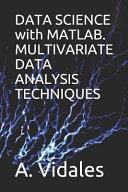Multivariate statistical techniques include supervised and unsupervised learning techniques. This book develops supervised analysis techniques such as decision trees and discriminant analysis models. It also develops non-supervised analysis techniques such as cluster analysis, dimension reduction and multidimensional scaling.Multidimensional scaling (MDS) is a set of methods that address all these problems. MDS allows you to visualize how near points are to each other for many kinds of distance or dissimilarity metrics and can produce a representation of your data in a small number of dimensions. MDS does not require raw data, but only a matrix of pairwise distances or dissimilarities.Feature selection reduces the dimensionality of data by selecting only a subset of measured features (predictor variables) to create a model. Selection criteria usually involve the minimization of a specific measure of predictive error for models fit to different subsets. Algorithms search for a subset of predictors that optimally model measured responses, subject to constraints such as required or excluded features and the size of the subset.Factor analysis is a way to fit a model to multivariate data to estimate just this sort of interdependence. In a factor analysis model, the measured variables depend on a smaller number of unobserved (latent) factors. Because each factor might affect several variables in common, they are known as common factors. Each variable is assumed to be dependent on a linear combination of the common factors, and the coefficients are known as loadings. Each measured variable also includes a component due to independent random variability, known as specific variance because it is specific to one variable.Cluster analysis, also called segmentation analysis or taxonomy analysis, creates groups, or clusters, of data. Clusters are formed in such a way that objects in the same cluster are very similar and objects in different clusters are very distinct. Measures of similarity depend on the application.Decision trees, or classification trees and regression trees, predict responses to data. To predict a response, follow the decisions in the tree from the root (beginning) node downto a leaf node. The leaf node contains the response. Classification trees give responses that are nominal, such as 'true' or 'false'. Regression trees give numeric responses. Statistics and Machine Learning Toolbox trees are binary. Each step in a prediction involves checking the value of one predictor (variable).Discriminant analysis is a classification method. It assumes that differen classes generate data based on different Gaussian distributions. Linear discriminant analysis is also known as the Fisher discriminant, named for its inventor.
Multivariate statistical techniques include supervised and unsupervised learning techniques. This book develops supervised analysis techniques such as decision trees and discriminant analysis models.


